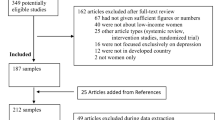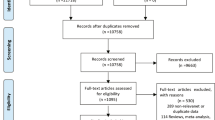Abstract
Postpartum depression (PPD) affects nearly 20% of postpartum women and has severe short- and long-term detrimental effects on their mental health. While there is ample evidence linking depression-related outcomes and individuals’ socioeconomic status (SES), the examination of differences in PPD as a function of SES has received relatively little empirical attention, resulting in inconsistent empirical evidence. There are also no well-established systematic reviews on the linkage between SES and PPD. Thus, we conducted A PRISMA-compliant systematic review to comprehensively analyze the association of SES (as measured by long-established objective [e.g., income or education] and subjective measures) with PPD (as measured by widely validated scales). We performed a bibliographic search on CINAHL Complete, MEDLINE complete, and EBSCO Psychology and Behavioral Sciences Collection. Among the 201 articles retrieved, 16 met the eligibility criteria. Our results reveal that mothers with lower income and education levels (objective indicators of SES) were more likely to experience PPD. Notably, we also found that subjective SES, compared to objective SES, was more strongly associated with PPD. Overall, these findings indicate that low-SES mothers may be at increased risk of PPD compared to high-SES mothers, reflecting the need for more efficient early detection programs for PPD among low-SES mothers.

Similar content being viewed by others
Data availability
Data sharing not applicable to this article as no datasets were generated or analyzed during the current study.
References
Acuña Alvarado, A., Ramírez Zumbado, E., & Azofeifa Zumbado, M. (2021). Depresión postparto. Revista Médica Sinergia, 6(9), e712. https://doi.org/10.31434/rms.v6i9.712
Adler, N. E., Epel, E. S., Castellazzo, G., & Ickovics, J. R. (2000). Relationship of subjective and objective social status with psychological and physiological functioning: Preliminary data in healthy white women. Health Psychology, 19(6), 586–592. https://doi.org/10.1037/0278-6133.19.6.586
American Psychiatric Association (APA). (2014). Manual diagnóstico y estadístico de los Trastornos mentales DSM-5 (5a. ed.). Editorial Médica Panamericana.
Bahk, J., Yun, S. C., Kim, Y., & Khang, Y. H. (2015). Changes in the relationship between socioeconomic position and maternal depressive symptoms: Results from the panel study on Korean Children (PSKC). Maternal and Child Health Journal, 19(9), 2057–2065. https://doi.org/10.1007/s10995-015-1718-x
Beck, A. T., Ward, C. H., Mendelson, M., Mock, J., & Erbaugh, J. (1961). An inventory for measuring depression. Archives of General Psychiatry, 4, 561–571.
Bergant, A. M., Nguyen, T., Heim, K., Ulmer, H., & Dapunt, O. (1998). German language version and validation of the Edinburgh postnatal depression scale. Deutsche Medizinische Wochenschrift, 123(3), 35–40. https://doi.org/10.1055/s-2007-1023895
Beeghly, M., Olson, K. L., Weinberg, M. K., Pierre, S. C., Downey, N., & Tronick, E. Z. (2003). Prevalence, stability, and socio-demographic correlates of depressive symptoms in black mothers during the first 18 months postpartum. Maternal and Child Health Journal, 7(3), 157–168. https://doi.org/10.1023/a:1025132320321
Cena, L., Mirabella, F., Palumbo, G., Gigantesco, A., Trainini, A., & Stefana, A. (2021). Prevalence of maternal antenatal and postnatal depression and their association with sociodemographic and socioeconomic factors: A multicentre study in Italy. Journal of Affective Disorders, 279, 217–221. https://doi.org/10.1016/j.jad.2020.09.136
Cox, J. L., Holden, J. M., & Sagovsky, R. (1987). Detection of postnatal depression: Development of the 10-item Edinburgh postnatal depression scale. British Journal of Psychiatry, 150, 782–786.
Dearing, E., Taylor, B. A., & McCartney, K. (2004). Implications of family income dynamics for women’s depressive symptoms during the first 3 years after childbirth. American Journal of Public Health, 94(8), 1372–1377. https://doi.org/10.2105/ajph.94.8.1372
Dennis, E. F., Webb, D. A., Lorch, S. A., Mathew, L., Bloch, J. R., & Culhane, J. F. (2012). Subjective social status and maternal health in a low-income urban population. Maternal and Child Health Journal, 16(4), 834–843. https://doi.org/10.1007/s10995-011-0791-z
Dolbier, C., Rush, T., Sahadeo, L., Shaffer, M., & Thorp, J. (2013). Relationships of race and socioeconomic status to postpartum depressive symptoms in rural African American and non-hispanic white women. Maternal & Child Health Journal, 17(7), 1277–1287. https://doi.org/10.1007/s10995-012-1123-7
Gausia, K., Fisher, C., Algin, S., & Oosthuizen, J. (2007). Validation of the Bangla version of the Edinburgh postnatal depression scale for a Bangladeshi sample. Journal of Reproductive and Infant Psychology, 25(4), 308–315.
Goyal, D., Gay, C., & Lee, K. A. (2010). How much does low socioeconomic status increase the risk of prenatal and postpartum depressive symptoms in first-time mothers? Women’s Health Issues: Official Publication of the Jacobs Institute of Women’s Health, 20(2), 96–104. https://doi.org/10.1016/j.whi.2009.11.003
Hahn-Holbrook, J., Cornwell-Hinrichs, T., & Anaya, I. (2018). Economic and health predictors of national postpartum depression prevalence: A systematic review, meta-analysis, and meta-regression of 291 studies from 56 countries. Frontiers In Psychiatry, 8. https://doi.org/10.3389/fpsyt.2017.00248
Hein, A., Rauh, C., Engel, A., Häberle, L., Dammer, U., Voigt, F., Fasching, P. A., Faschingbauer, F., Burger, P., Beckmann, M. W., Kornhuber, J., & Goecke, T. W. (2014). Socioeconomic status and depression during and after pregnancy in the franconian maternal health evaluation studies (FRAMES). Archives of Gynecology and Obstetrics, 289(4), 755–763. https://doi.org/10.1007/s00404-013-3046-ywe
Kessler, R. C., Barker, P. R., Colpe, L. J., Epstein, J. F., Gfroerer, J. C., Hiripi, E., Howes, M. J., Normand, S. L. T., Manderscheid, R. W., Walters, E. E., & Zaslavsky, A. M. (2003). Screening for serious mental illness in the general population. Archives of General Psychiatry, 60(2), 184–189.
Lara, M., Navarrete, L., & Nieto, L. (2016). Prenatal predictors of postpartum depression and postpartum depressive symptoms in Mexican mothers: A longitudinal study. Archives of Women’s Mental Health, 19(5), 825–834. https://doi.org/10.1007/s00737-016-0623-7
Matsumura, K., Hamazaki, K., Tsuchida, A., Kasamatsu, H., & Inadera, H. (2019). Education level and risk of postpartum depression: Results from the Japan Environment and Children’s Study (JECS). BMC Psychiatry, 19(1), 419. https://doi.org/10.1186/s12888-019-2401-3
Mayberry, L. J., Horowitz, J. A., & Declercq, E. (2007). Depression symptom prevalence and demographic risk factors among U.S. women during the first 2 years postpartum. Journal of Obstetric Gynecologic and Neonatal Nursing: JOGNN, 36(6), 542–549. https://doi.org/10.1111/j.1552-6909.2007.00191.x
Melchior, M., Chastang, J. F., de Lauzon, B., Galéra, C., Saurel-Cubizolles, M. J., Larroque, B., & EDEN Mother–Child Cohort Study Group. (2012). Maternal depression, socioeconomic position, and temperament in early childhood: The EDEN Mother-Child Cohort. Journal of Affective Disorders, 137(1–3), 165–169. https://doi.org/10.1016/j.jad.2011.09.018
Melnyk, B. M., & Fineout-Overholt, E. (2023). Evidence-based practice in nursing and healthcare: A guide to best practice (5th ed.). Wolters Kluwer.
Miyake, Y., Tanaka, K., Sasaki, S., & Hirota, Y. (2011). Employment, income, and education and risk of postpartum depression: The Osaka Maternal and Child Health Study. Journal of Affective Disorders, 130(1–2), 133–137. https://doi.org/10.1016/j.jad.2010.10.024
Moher, D., Liberati, A., Tetzlaff, J., Altman, D. G., & PRISMA Group. (2009). Preferred reporting items for systematic reviews and meta-analyses: the PRISMA statement. BMJ (Clinical research ed.), 339, b2535. https://doi.org/10.1136/bmj.b2535
Navarro-Carrillo, G., Alonso-Ferres, M., Moya, M., & Valor-Segura, I. (2020). Socioeconomic status and psychological well-being: Revisiting the role of subjective socioeconomic status. Frontiers in Psychology, 11, 1303. https://doi.org/10.3389/fpsyg.2020.01303
Navarro-Carrillo, G., Valor-Segura, I., & Moya, M. (2021). The consequences of the perceived impact of the Spanish economic crisis on subjective well-being: The explanatory role of personal uncertainty. Current Psychology, 40, 5286–5300. https://doi.org/10.1007/s12144-019-00506-4
O’Hara, M., & McCabe, J. (2013). Postpartum depression: current status and future directions. Annual Review of Clinical Psychology, 9(1), 379–407. https://doi.org/10.1146/annurev-clinpsy-050212-185612
Okano, T., Murata, M., Masuji, F., Tamaki, R., Nomura, J., Miyaoka, H., & Kitamura, T. (1996). Validation and reliability of Japanese version of the EPDS. Archives of Psychiatry and Diagnosis in Clinical Evaluation, 7, 525–533.
Oztora, S., Arslan, A., Caylan, A., & Dagdeviren, H. N. (2019). Postpartum depression and affecting factors in primary care. Nigerian Journal of Clinical Practice, 22(1), 85–91. https://doi.org/10.4103/njcp.njcp_193_17
Radloff, L. S. (1977). The CES-D scale: a self-report depression scale for research in the general population. Applied Psychological Measurement, 1(3), 385–401. https://doi.org/10.1177/014662167700100306
Ridley, M., Rao, G., Schilbach, F., & Patel, V. (2020). Poverty, depression, and anxiety: Causal evidence and mechanisms. Science, 370(6522), eaay0214. https://doi.org/10.1126/science.aay0214
Rubertsson, C., Wickberg, B., Gustavsson, P., & Rådestad, I. (2005). Depressive symptoms in early pregnancy, two months and one year postpartum-prevalence and psychosocial risk factors in a national Swedish sample. Archives of Women’s Mental Health, 8(2), 97–104. https://doi.org/10.1007/s00737-005-0078-8
Santos, M. F. S., Martins, F. C., & Pasquali, L. (1999). Escalas De auto-avaliação de depressão pós-parto: Um estudo no Brasil. Revista De Psiquiatria Clínica, 26(2), 32–40.
SéAguin, L., Potvin, L., St-Denis, M. & Loiselle, J. (1999). Socio-environmental factors and postnatal depressive symptomatology: A longitudinal study. Women & Health, 29(1), 57–72. https://doi.org/10.1300/j013v29n01_05
Segre, L. S., O’Hara, M. W., Arndt, S., & Stuart, S. (2007). The prevalence of postpartum depression: The relative significance of three social status indices. Social Psychiatry and Psychiatric Epidemiology, 42(4), 316–321. https://doi.org/10.1007/s00127-007-0168-1
Slomian, J., Honvo, G., Emonts, P., Reginster, J. Y., & Bruyère, O. (2019). Consequences of maternal postpartum depression: A systematic review of maternal and infant outcomes. Women’s Health, 15, 1745506519844044. https://doi.org/10.1177/1745506519844044
Tannous, L., Gigante, L. P., Fuchs, S. C., & Busnello, E. D. (2008). Postnatal depression in Southern Brazil: Prevalence and its demographic and socioeconomic determinants. Bmc Psychiatry, 8(1). https://doi.org/10.1186/1471-244X-8-1
Tariq, N., Naeem, H., Tariq, A., & Naseem, S. (2021). Maternal depression and its correlates – a longitudinal study. Journal of the Pakistan Medical Association, 1–13. https://doi.org/10.47391/jpma.352
Valdes, V., Berens, A. E., & Nelson, C. A. (2021). Socioeconomic and psychological correlates of postpartum depression at 6 months in Dhaka, Bangladesh. International Journal of Psychology, 56(5), 729–738. https://doi.org/10.1002/ijop.12735
Van Niel, M. S., & Payne, J. L. (2020). Perinatal depression: A review. Cleveland Clinic Journal of Medicine, 87(5), 273–277. https://doi.org/10.3949/ccjm.87a.19054
Wang, Z., Liu, J., Shuai, H., Cai, Z., Fu, X., Liu, Y., et al. (2021). Mapping global prevalence of depression among postpartum women. Translational Psychiatry, 11(1). https://doi.org/10.1038/s41398-021-01663-6
Werner, E., Miller, M., Osborne, L. M., Kuzava, S., & Monk, C. (2015). Preventing postpartum depression: Review and recommendations. Archives of Women’s Mental Health, 18(1), 41–60. https://doi.org/10.1007/s00737-014-0475-y
Zhao, X., & Zhang, Z. (2020). Risk factors for postpartum depression: An evidence-based systematic review of systematic reviews and meta-analyses. Asian Journal of Psychiatry, 53, 102353. https://doi.org/10.1016/j.ajp.2020.102353
Zimmerman, M., Coryell, W., Corenthal, C., & Wilson, S. (1986). A self-report scale to diagnose major depressive disorder. Archives of General Psychiatry, 43(11), 1076–1081. https://doi.org/10.1001/archpsyc.1986.01800110062008
Funding
This research was supported by the Project PID2020-114464RB-I00 funded by MCIN/AEI/10.13039/501100011033. It was also supported by the Grant SCIA-ANID CIE160009 from the Agencia Nacional de Investigación y Desarrollo de Chile.This research was supported by the Project PID2020-114464RB-I00 funded by MCIN/AEI/https://doi.org/10.13039/501100011033 . It was also supported by the Grant SCIA-ANID CIE160009 from the Agencia Nacional de Investigación y Desarrollo de Chile.
Author information
Authors and Affiliations
Corresponding author
Ethics declarations
Ethical approval
This article does not contain any studies with human participants performed by any of the authors.
Informed consent
Informed consent was not relevant to the content of this manuscript.
Consent to participate
Not applicable.
Consent for publication
Not applicable.
Conflict of interest
We have no conflict of interest to disclose.
Additional information
Publisher’s Note
Springer Nature remains neutral with regard to jurisdictional claims in published maps and institutional affiliations.
Rights and permissions
Springer Nature or its licensor (e.g. a society or other partner) holds exclusive rights to this article under a publishing agreement with the author(s) or other rightsholder(s); author self-archiving of the accepted manuscript version of this article is solely governed by the terms of such publishing agreement and applicable law.
About this article
Cite this article
Szurek-Cabanas, R., Navarro-Carrillo, G., Martínez-Sánchez, C.A. et al. Socioeconomic status and maternal postpartum depression: a PRISMA-compliant systematic review. Curr Psychol (2024). https://doi.org/10.1007/s12144-024-05774-3
Accepted:
Published:
DOI: https://doi.org/10.1007/s12144-024-05774-3




